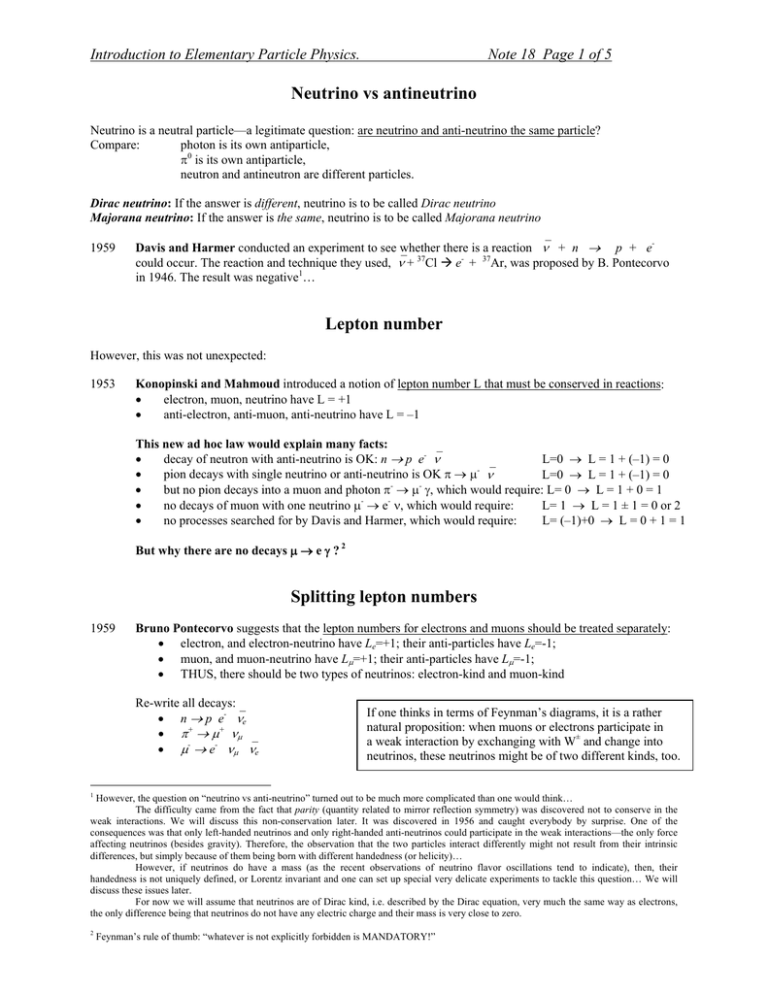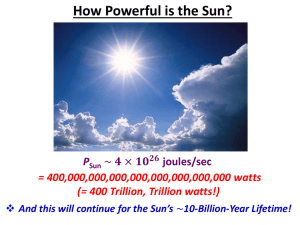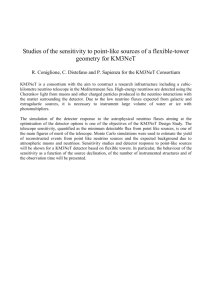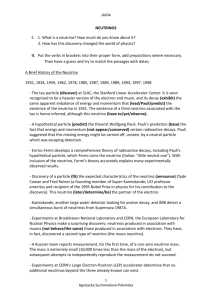Neutrino vs antineutrino
advertisement

Introduction to Elementary Particle Physics. Note 18 Page 1 of 5 Neutrino vs antineutrino Neutrino is a neutral particle—a legitimate question: are neutrino and anti-neutrino the same particle? Compare: photon is its own antiparticle, π0 is its own antiparticle, neutron and antineutron are different particles. Dirac neutrino: If the answer is different, neutrino is to be called Dirac neutrino Majorana neutrino: If the answer is the same, neutrino is to be called Majorana neutrino 1959 Davis and Harmer conducted an experiment to see whether there is a reaction ⎯ν + n → p + ecould occur. The reaction and technique they used,⎯ν + 37Cl Æ e- + 37Ar, was proposed by B. Pontecorvo in 1946. The result was negative1… Lepton number However, this was not unexpected: 1953 Konopinski and Mahmoud introduced a notion of lepton number L that must be conserved in reactions: • electron, muon, neutrino have L = +1 • anti-electron, anti-muon, anti-neutrino have L = –1 This new ad hoc law would explain many facts: L=0 → L = 1 + (–1) = 0 • decay of neutron with anti-neutrino is OK: n → p e-⎯ν • pion decays with single neutrino or anti-neutrino is OK π → μ-⎯ν L=0 → L = 1 + (–1) = 0 • but no pion decays into a muon and photon π- → μ- γ, which would require: L= 0 → L = 1 + 0 = 1 L= 1 → L = 1 ± 1 = 0 or 2 • no decays of muon with one neutrino μ- → e- ν, which would require: • no processes searched for by Davis and Harmer, which would require: L= (–1)+0 → L = 0 + 1 = 1 But why there are no decays μ → e γ ? 2 Splitting lepton numbers 1959 Bruno Pontecorvo suggests that the lepton numbers for electrons and muons should be treated separately: • electron, and electron-neutrino have Le=+1; their anti-particles have Le=-1; • muon, and muon-neutrino have Lμ=+1; their anti-particles have Lμ=-1; • THUS, there should be two types of neutrinos: electron-kind and muon-kind Re-write all decays: • n → p e- ⎯νe • π+ → μ+ νμ • μ- → e- νμ ⎯νe If one thinks in terms of Feynman’s diagrams, it is a rather natural proposition: when muons or electrons participate in a weak interaction by exchanging with W± and change into neutrinos, these neutrinos might be of two different kinds, too. 1 However, the question on “neutrino vs anti-neutrino” turned out to be much more complicated than one would think… The difficulty came from the fact that parity (quantity related to mirror reflection symmetry) was discovered not to conserve in the weak interactions. We will discuss this non-conservation later. It was discovered in 1956 and caught everybody by surprise. One of the consequences was that only left-handed neutrinos and only right-handed anti-neutrinos could participate in the weak interactions—the only force affecting neutrinos (besides gravity). Therefore, the observation that the two particles interact differently might not result from their intrinsic differences, but simply because of them being born with different handedness (or helicity)… However, if neutrinos do have a mass (as the recent observations of neutrino flavor oscillations tend to indicate), then, their handedness is not uniquely defined, or Lorentz invariant and one can set up special very delicate experiments to tackle this question… We will discuss these issues later. For now we will assume that neutrinos are of Dirac kind, i.e. described by the Dirac equation, very much the same way as electrons, the only difference being that neutrinos do not have any electric charge and their mass is very close to zero. 2 Feynman’s rule of thumb: “whatever is not explicitly forbidden is MANDATORY!” Introduction to Elementary Particle Physics. Note 18 Page 2 of 5 Discovery of Muon Neutrino 1962 Lederman, Schwarts, Steinberger (Brookhaven) make an experiment to check whether muon and electron neutrino indeed different. One has to start from muon neutrinos and see whether all they can make are muons: ⎯νμ + p → νμ + n → n + μ+ p + μ- Pions is an excellent source of muon neutrinos… The idea of neutrino beams actually belongs to Pontecorvo… • • 15 GeV protons → Be target → lots of pions: π+, π-, π0 20 m decay distance: not too short (good fraction of pions decay), not too long (muons do not decay) π+ → μ+ νμ (10-8 s), μ+ → e+ νe ⎯νμ (10-6 s) π- → μ-⎯νμ (10-8 s), μ- → e- νμ ⎯νe (10-6 s), → lots of photons, pions, muons, and high energy muon neutrinos and antineutrinos • • • 13 m of steel to absorb all particles but neutrinos; spark chamber with Al sheets cover detectors with scintillator to veto cosmic rays → 1014 muon neutrinos and antineutrinos muons should produce nice tracks running throughout the entire detector (29 events) electrons should produce showers as they cross Al sheets (none) Mass limit from direct mass measurements <200 keV 1988 Lederman, Schwarts, Steinberger receive the Nobel Prize "for the neutrino beam method and the demonstration of the doublet structure of the leptons through the discovery of the muon neutrino" Introduction to Elementary Particle Physics. Note 18 Page 3 of 5 Discovery of τ-lepton 1975 Mark I experiment at SPEAR (Stanford Linear Accelerator Center) claims discovering new lepton. Most of the work on this analysis was credited to Martin Perl. No one could come up with any plausible background source for these mixed pairs τ-lepton has a mass of 1.777 GeV and lifetime of 2.9×10-13 s. It has lots of modes of decays: ~18% τ- → e- ⎯νe ντ ~17% τ- → μ- ⎯νμ ντ ~64% τ- → hadrons + ντ (Now, WHO the hell ordered THAT?) 1995 Perl receives the Nobel Prize "for the discovery of the τ-lepton" Introduction to Elementary Particle Physics. Note 18 Page 4 of 5 Discovery of τ-neutrino 2000 DONUT experiment at Fermilab claims discovering τ-neutrino (spokesmen Lundberg, and Paolone) 6,000,000 candidates on the “tape” 4 clean τ-decay events… truly “one in a million” Mass limit from direct mass measurements in τ-lepton decays <24 MeV (different experiments) Introduction to Elementary Particle Physics. Note 18 Page 5 of 5 Lepton Universality Muon and tau-lepton lifetimes: τ − → e −ν eν τ Γτ →eνν = 2π M ρ 2 GeV = 1 (GeV 5 ) GeV 4 ρ must have dimentions of (GeV 5 ), while the only energy variable available is tau mass mτ ( me and mμ can be neglected) Γτ →eνν = 2πG 2 mτ5 Γτ →eνν = 0.1784 ⋅ Γtotal 1 τ τ (lifetime) = Γtotal = 0.1784 2πG 2 mτ5 = 1 2πG 2 mμ5 μ − → e −ν eν μ Γμ →eνν = 2πG 2 mμ5 τ μ (lifetime) = 1 Γtotal mμ ττ = 0.1784 5 = 1.33 × 10 −7 τμ mτ 5 Prediction: Experiment: τ τ 2.9 × 10 −13 = = 1.32 × 10 −7 −6 2 . 2 × 10 τμ Branching ratios of tau-lepton decaying into a muon or electron: τ − → μ −ν μν τ Γτ → μνν = 2π M ρ μ = 2πG 2 mτ5 τ − → e −ν eν τ Γτ →eνν = 2π M ρ e = 2πG 2 mτ5 2 2 Γτ → μνν = Br(τ → μνν ) ⋅ Γtotal Γτ →eνν = Br (τ → eνν ) ⋅ Γtotal Prediction: Experiment: Br(τ → eνν ) Γτ →eνν = =1 Br (τ → μνν ) Γτ → μνν Br (τ → eνν ) 0.1884 = = 1.03 Br(τ → μνν ) 0.1737 Note: this does not work for pion decays into muon or electron: π → μ ν (99.99%) π → e ν (0.01%) There are special reasons for that to be discussed later…







